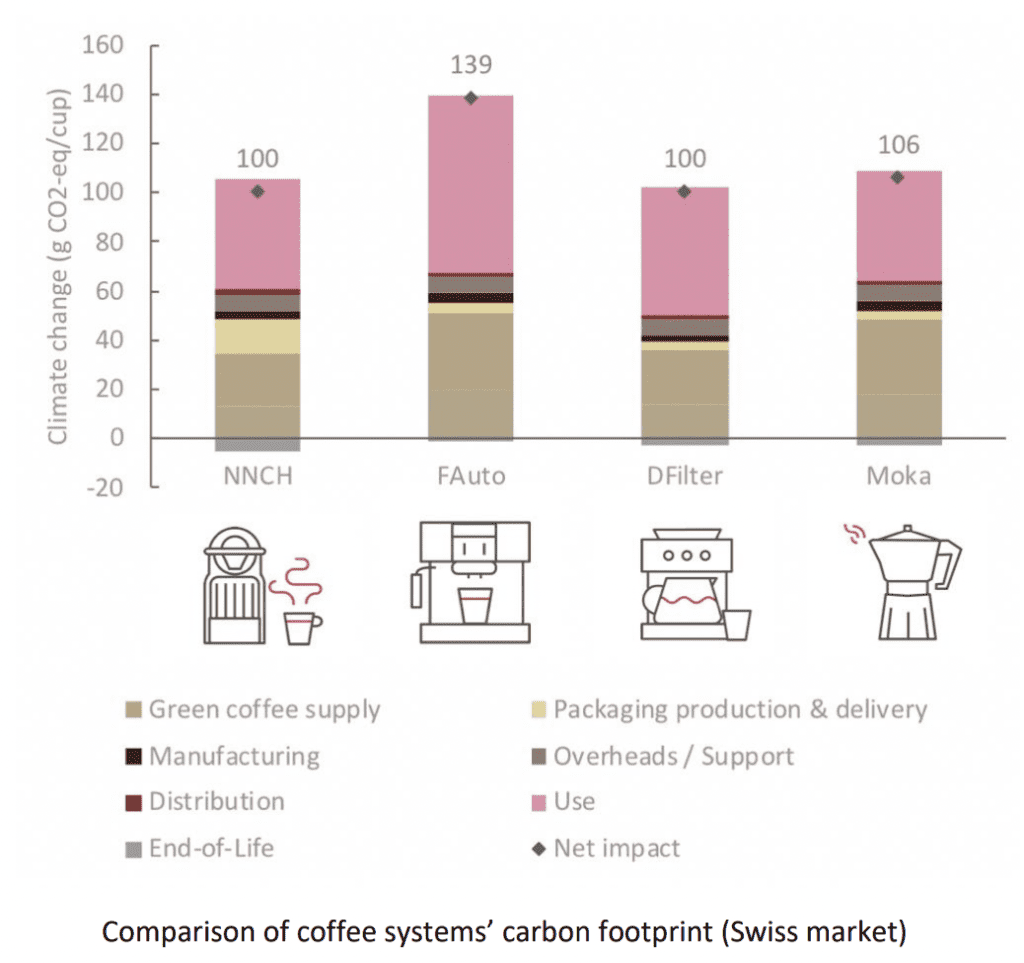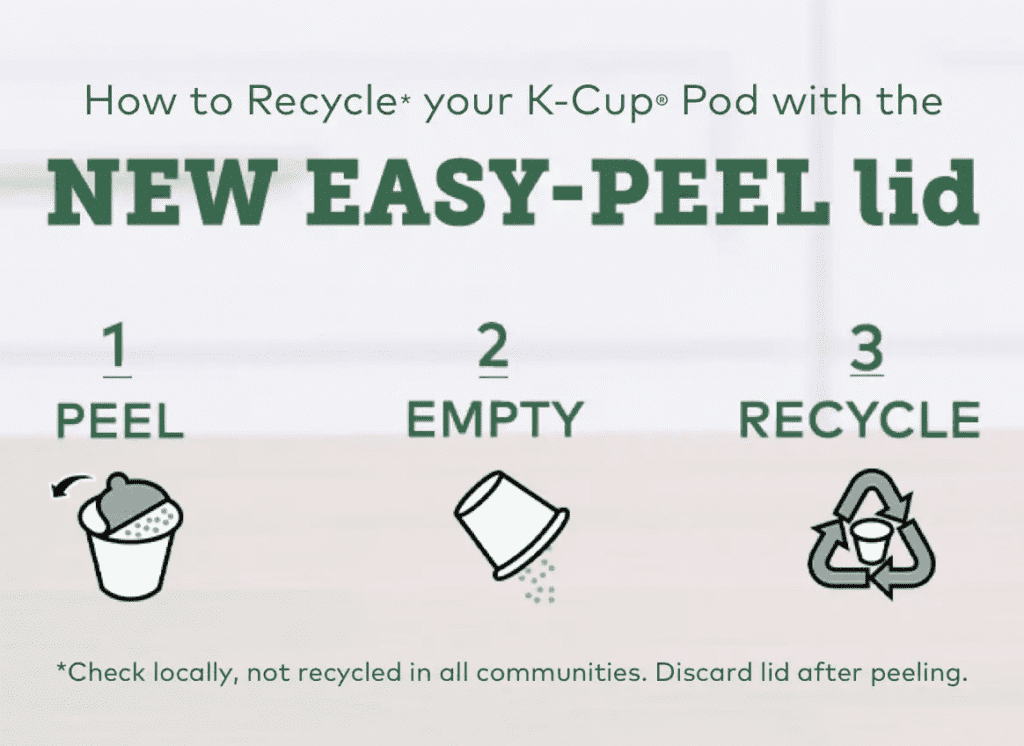Introduction – An Unusually Complicated Analysis
Do you think about coffee and ever wonder are coffee pods sustainable? On the one hand manufacturers have made changes to their products to ease recycling. On the other hand, coffee pods certainly seem to be a much more waste-generating product than old-fashioned brewing methods. But it turns out the answer is much more complicated than we imagined!
If you want the quick answer, then coffee pods are similar to filter coffee in terms of sustainability. Existing analyses suggest coffee pods definitely beat store-bought coffee in sustainability. If you want the full, complicated answer, read on.
What Are Coffee Pods?
Coffee pods are small, single-serving coffee filters that contain coffee grounds. They are designed to be used with coffee pod machines, which brew coffee by passing hot water through the coffee grounds.

Are Coffee Pods Sustainable?
Coffee pods have become increasingly popular in recent years, as they offer a convenient and easy way to make coffee at home. However, there is some debate over whether coffee pods are sustainable, as they can be made from non-recyclable materials and generate a lot of waste. To answer the question of whether coffee pods are sustainable, we take a look at the lifecycle of a coffee pod and consider the environmental impact at each stage.
A simple life cycle consideration of a coffee pod
The first stage is the production of coffee pods. Most coffee pods are made from plastic or aluminum. If consumers don’t recycle them, they end up in landfills. That’s harmful because of the relatively greater resource usage to produce the pods compared to traditional brewing methods. The greater resource usage means more carbon emissions.
The second stage is use of the coffee pod to make coffee. Coffee pods use a lot of coffee, which has the potential to harm the environment. It takes around 2,500 coffee beans to make one kilogram of coffee. This means that coffee pods have a large carbon footprint.
The third stage is disposal of the coffee pod. Recycled pods (possible for the newer types based on recyclable plastic materials) reduce impact on landfills. Non-recycled pods end up in landfills. This means the pods will undergo degradation and further generation of green house gases. So coffee pods contribute to climate change.
Overall, it is clear that coffee pods have a significant environmental impact at each stage of their lifecycle. From production to disposal, coffee pods generate a lot of waste and greenhouse gas emissions. This makes coffee pods unsustainable and bad for the environment.
The true comparison is head-to-head. We shouldn’t be asking whether a coffee pod is sustainable or not. We should be asking whether the coffee pod is more or less sustainable than its alternatives such as store-brewed or home-brewed coffee. Because a coffee drinker will be getting a coffee product, we should ask for a comparison of the different products.
Study 1: Nestle and Quantis study of carbon footprint: coffee capsules vs drip coffee vs Starbucks-style store coffee
The best way to answer this question is with data. And if the data is impossible to generate in one-go, a substitute is a breakdown analysis. Here is a study that we liked even though we’re not sure if the results were fully free of conflict-of-interest. Again, the correct comparison then is the relative sustainability of coffee pods, drip coffee and Starbucks style coffee.
Nestle commissioned a study by Quantis, a consulting company. The study is also published here. Quantis carried out a full life cycle analysis of 4 options. The first was the Nestle single use product. The second was the fully automatic coffee machine, such as a Delonghi branded machine. The Delonghi system stands in for what you might find at a Starbucks – a sophisticated machine for making a single serve coffee. The third was a simple drip system that many people use at home. The fourth was a Moka stove-top boiler.

The study found that the coffee pod machine, the filter method, and the stove-top method were all very similar in terms of the carbon emissions. Remarkably, the quantity of carbon emitted was about 100 g CO2 per coffee. This is about the same as driving a mile in an efficient car. The worst was the fully automatic machine, aka the fancy coffee store equivalent.
Caveat: Nestle commissioned this study. I wonder if Quantis felt they had to give their client a favorable answer. We’d love to see an independent assessment free of conflict of interest.
Study 2: KTH study on coffee capsules vs filter coffee
Here’s another study we liked and not commissioned by a coffee company. Researchers at KTH, the Royal Institute of Technology Stockholm, carried out another study following coffee beans from source to an imaginary consumer in Stockholm via 2 routes: a coffee capsule route and a filter coffee route. The analysis is complicated. They considered many quantitative factors to model the path from source to consumer. It generated intermediate results comparing impact on different categories of interest. One chart shows below the impact of capsules vs filter for 18 categories of harm, such as “terrestrial acidification” and “freshwater ecotoxicity”.

Surprisingly, the researchers found that the capsules won on less impact in every scenario. The reasoning was simple: measuring filter coffee is imprecise and consumeres use more beans than needed whereas capsules are super precise. The precision usage meant less waste and less impact.
Are Coffee Pods And Coffee Capsules Different?
There is a distinction between coffee capsules and coffee pods, even though the terms are frequently used interchangeably. Coffee grounds and filter paper are used in the production of coffee pods, whilst coffee grounds are combined with either plastic or aluminum in the manufacture of coffee capsules.
Which Is More Expensive?
The cost of coffee capsules is significantly lower than that of coffee pods. Coffee capsules are typically half as expensive as coffee pods, while pods can cost up to twice as much. This is because manufacturers make coffee pods using coffee grounds and filter paper, two components that are more costly than plastic or metal.
Are Coffee Pods Environmentally Friendly?
As we saw from the Nestle-Quantis study, and the KTH study, the answer is not straightforward. In recent years, there has been a significant increase in the rate of growth of the coffee pod sector. This is because coffee pods provide a quick and simple method for preparing coffee at home. However, the viability of coffee pods as a sustainable product has been called into question because they can be constructed from materials that cannot be recycled and produce a significant amount of trash.
The Future For Capsule Sustainability

The coffee pod industry is growing at a rapid rate. In 2015, coffee pods represented a $7.2 billion global market, and this figure is expected to rise to $19.8 billion by 2025. This increase can be attributed to the growing popularity of coffee pods as a convenient way to make coffee at home. However, the sustainability of coffee pods has been called into question because they are made from non-recyclable materials and generate large amounts of waste.
As coffee pods become more popular, it is important to consider their environmental impact. From production to disposal, coffee pods have a significant impact on the environment. This makes them unsustainable and bad for the environment. If coffee pods continue to be used at their current rate, their environmental impact will likely increase. This could have a detrimental effect on the environment, so it is important to find a more sustainable way to prepare coffee at home.
Check This Out: What is Natural Dish Soap – Stripping Out Artificial Ingredients
Ways to achieve sustainability
We conclude that there’s no data to show capsules/pods are worse than alternatives. However, we still have the option of mitigating our impact when using coffee pods.
- Recycle the Pods – One way to make coffee pods more sustainable is to recycle them. Recycling coffee pods can reduce their environmental impact by prolonging their lifespan and preventing them from ending up in landfill sites. Several companies offer coffee pod recycling services, so it is worth considering this option if you use coffee pods at home.
- Buy A Machine Made of Recycled Materials – Another way to make coffee pods more sustainable is to choose a coffee pod machine that uses recycled materials. Some coffee pod machines are made from recycled plastics and metals, which reduces their environmental impact. It is also important to choose a coffee pod machine that is easy to clean and maintain, as this will prolong its lifespan and reduce the amount of waste it produces.
- Use Sustainable Beans – Finally, it is important to consider the coffee that you use in your coffee pods. Some coffee beans are more sustainable than others, so it is worth choosing a coffee that is grown sustainably and has a low environmental impact. Several Fairtrade coffee brands offer sustainable coffee beans, so it is worth considering this option when buying coffee for your coffee pods.
While coffee pods offer a convenient way to make coffee at home, their sustainability is unclear. If you are concerned about the environment, it is important to consider the impact of coffee pods before using them. There are several ways to make coffee pods more sustainable, but the most effective way is to recycle them. You can also choose a coffee pod machine that uses recycled materials, and it is important to consider the coffee that you use in your coffee pods. If coffee pods continue to be used at their current rate, their environmental impact will likely increase.
Eco-Friendly Coffee Pods Brands
Nespresso – recyclable
Nespresso coffee pods are made from aluminum, which is 100% recyclable. They also offer a coffee pod recycling service, so you can recycle your coffee pods after use. They offer 3 ways to get the pods back to them. Look it up here. They let you drop it off at 1) a collection site, 2) a Nespresso Boutique, and 3) a postman! I’m not sure if any of these are available so you’re going to have to look it up yourselves.
Keurig – Keurig recycling site
Keurig coffee pods are made from plastic. According to Keurig’s website, since 2020 their coffee pods are recyclable. The website gives a three step instruction on recycling the pods. After the pod is used up, first take off the lid. Next, you need to dump out the coffee grounds. These are not part of the recycling process. Then the plastic pod itself is put into the recycling.

Lavazza – recycling site partnered with TerraCycle
Lavazza coffee pods are made from plastic and aluminum, both of which are recyclable. It also offers a coffee pod recycling service, so you can recycle your coffee pods after use. Lavazza works with TerraCycle. You’ll have to find a public drop off point. Look it up here.
Dolce Gusto – recycling site
Dolce Gusto coffee pods are plastic. The company offers a coffee pod recycling service, so you can recycle your coffee pods after use. Dolce Gusto is part of the Podback program. It appears there’s a curb-side pick up program, and a drop off program. Most certainly both are subject to local availability so you’re to have to find out.
Here’s where you can find out about curbside and dropoff programs: Podback site.
Tassimo – recycling site
Tassimo coffee pods are made from plastic. The company offers a coffee pod recycling service, so you can recycle your coffee pods after use. They use the recycling service Podback. Here’s an introductory video to the service.
The Bottom Line
Coffee pods, as far as we can tell, are comparable to other coffee brewing methods. Non-recyclable materials and a high volume of garbage make coffee pods are a point of improvement for environment. It seems anticipated that the environmental impact of coffee pods will increase if they continue to be utilized at their current rate to avoid harming the environment, finding a more environmentally friendly method of brewing coffee at home is essential.
Reusing and recycling coffee pods is one technique to reduce their environmental impact. By extending the life of the coffee pods and keeping them out of landfills, recycling coffee pods can have a positive impact on the environment. If you use coffee pods at home, you may want to look into coffee pod recycling services.
